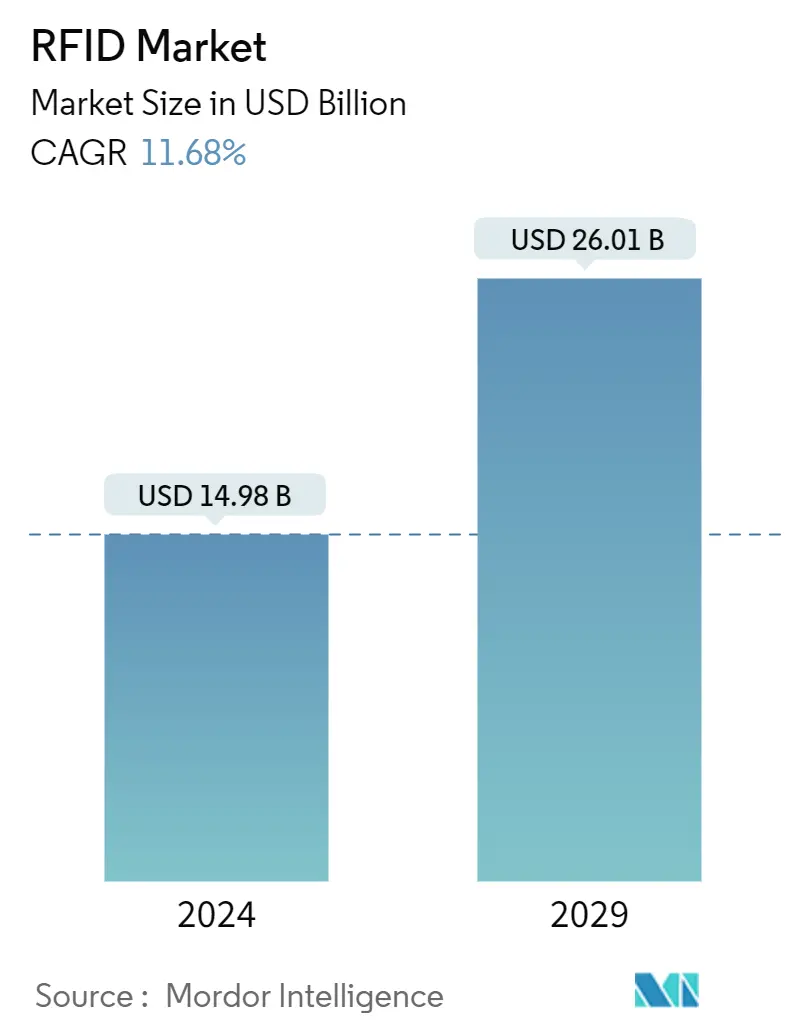Market Size of RFID Industry

| Study Period | 2019 - 2029 |
| Market Size (2024) | USD 14.98 Billion |
| Market Size (2029) | USD 26.01 Billion |
| CAGR (2024 - 2029) | 11.68 % |
| Fastest Growing Market | Asia-Pacific |
| Largest Market | North America |
Major Players
*Disclaimer: Major Players sorted in no particular order |
RFID Market Analysis
The RFID Market size is estimated at USD 14.98 billion in 2024, and is expected to reach USD 26.01 billion by 2029, growing at a CAGR of 11.68% during the forecast period (2024-2029).
Supply chain management and logistics make widespread usage of RFID technology. Sensor-based RFID technology is being increasingly integrated into product packaging to track and trace the origin of the product and prevent any source of contamination or tampering within the supply chain.
- Logistics and transportation are major areas of implementation for RFID technology. Warehouse management, yard management, shipping and freight, and distribution centers are some of the areas where RFID tracking technology is usually used.
- Radiofrequency identification (RFID) primarily refers to a wireless system comprising two major components: tags and readers. The reader is basically a device comprising one or more antennas that emits radio waves and receive signals back from the RFID tags. The tags, which make use of radio waves to communicate their identity and other crucial information to the nearby readers, can be passive or active type.
- The passive RFID tags are mainly powered by the readers and do not have a battery. However, the active type RFID tags are powered by batteries. These RFID tags can store a wide range of information, right from one serial number to several pages of crucial data. The RFID readers are offered in a mobile form factor so that they can be carried by hand or can either be mounted on a post or overhead.
- One of the most common usages of RFID technology has been tracking goods in the supply chain, tracking parts moving to a manufacturing production line, tracing assets, security, and payment systems that let clientele pay for items without using cash. In addition, RFID is frequently used in the healthcare industry on patient wristbands to offer tamper-proof, exact identification for facility access control and security.
- Moreover, multiple distribution centers and warehouses around the globe have been investing in improving their process efficiency to increase the efficiency of the overall processes as a part of their improvement programs. Such investments in the market landscape are anticipated to drive the growth and implementation of RFID technology.
- The COVID-19 pandemic has increased challenges for retailers. The pandemic also pushed retailers to adopt RFID on a much larger scale. The pandemic became an accelerator of the digital transformation trend, which was already underway.
RFID Industry Segmentation
RFID (Radio Frequency Identification) is a wireless system that comprises two components: tags and readers. The reader is a device with antennas that emit radio waves and receive signals from RFID tags. Tags are passive or active, communicating their identity and other information to nearby readers via radio waves. Passive RFID tags do not have a battery. The reader powers them. Batteries are usually used to power active RFID tags.
The RFID market is Segmented by technology (RFID tags, RFID interrogators, RFID software/services, and active RFID/RTLS), application (retail, healthcare and medical, passenger transport/automotive, manufacturing, and consumer products), and geography (North America, Europe, Asia-Pacific, Latin America, and Middle-East and Africa). The market size and forecasts are provided in terms of value (USD) for all the above segments.
| By Technology | |
| RFID Tags | |
| RFID Interrogators | |
| RFID Software/Services | |
| Active RFID/RTLS |
| By Application | |
| Retail | |
| Healthcare and Medical | |
| Passenger Transport/Automotive | |
| Manufacturing | |
| Consumer Products | |
| Other Applications |
| By Geography | |
| North America | |
| Europe | |
| Asia Pacific | |
| Latin America | |
| Middle East and Africa |
RFID Market Size Summary
The RFID market is poised for significant growth, driven by its extensive application in supply chain management, logistics, and retail sectors. RFID technology, which includes passive and active tags and readers, is increasingly integrated into various processes to enhance efficiency and accuracy. In logistics, RFID is utilized for tracking goods, managing warehouses, and ensuring the smooth operation of distribution centers. In retail, it streamlines inventory management, reduces theft, and improves customer experience through real-time data on stock levels and sales. The technology's ability to provide precise tracking and data collection is crucial for businesses aiming to optimize operations and reduce costs.
The Asia Pacific region is expected to hold a substantial share of the RFID market, fueled by the rapid adoption of automation and Industry 4.0 initiatives. The region's growth is further supported by the expanding retail sector and the increasing use of RFID in manufacturing to boost productivity. Despite challenges such as high installation costs and interoperability issues, the market is set to expand, driven by investments in asset management and the need for contactless solutions. Major players in the market are focusing on strategic collaborations and technological advancements to enhance their market presence and profitability.
RFID Market Size - Table of Contents
-
1. MARKET DYNAMICS
-
1.1 Market Drivers
-
1.1.1 Government Policies Favoring Digital Development
-
1.1.2 Increasing Installation of RFID in Manufacturing Units for Productivity Improvement and Security and Access Control Applications
-
-
1.2 Market Challenges
-
-
2. MARKET SEGMENTATION
-
2.1 By Technology
-
2.1.1 RFID Tags
-
2.1.2 RFID Interrogators
-
2.1.3 RFID Software/Services
-
2.1.4 Active RFID/RTLS
-
-
2.2 By Application
-
2.2.1 Retail
-
2.2.2 Healthcare and Medical
-
2.2.3 Passenger Transport/Automotive
-
2.2.4 Manufacturing
-
2.2.5 Consumer Products
-
2.2.6 Other Applications
-
-
2.3 By Geography
-
2.3.1 North America
-
2.3.2 Europe
-
2.3.3 Asia Pacific
-
2.3.4 Latin America
-
2.3.5 Middle East and Africa
-
-
RFID Market Size FAQs
How big is the RFID Market?
The RFID Market size is expected to reach USD 14.98 billion in 2024 and grow at a CAGR of 11.68% to reach USD 26.01 billion by 2029.
What is the current RFID Market size?
In 2024, the RFID Market size is expected to reach USD 14.98 billion.

